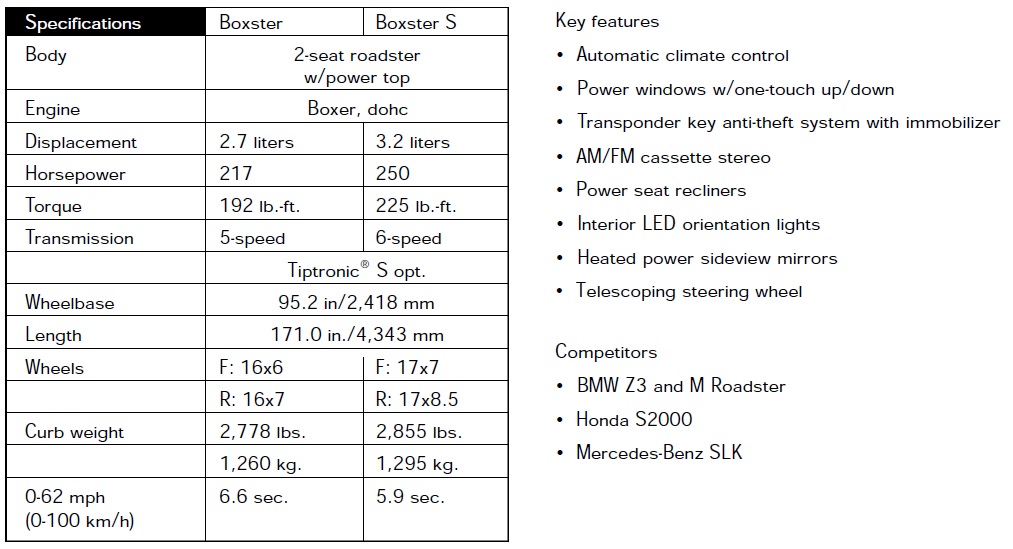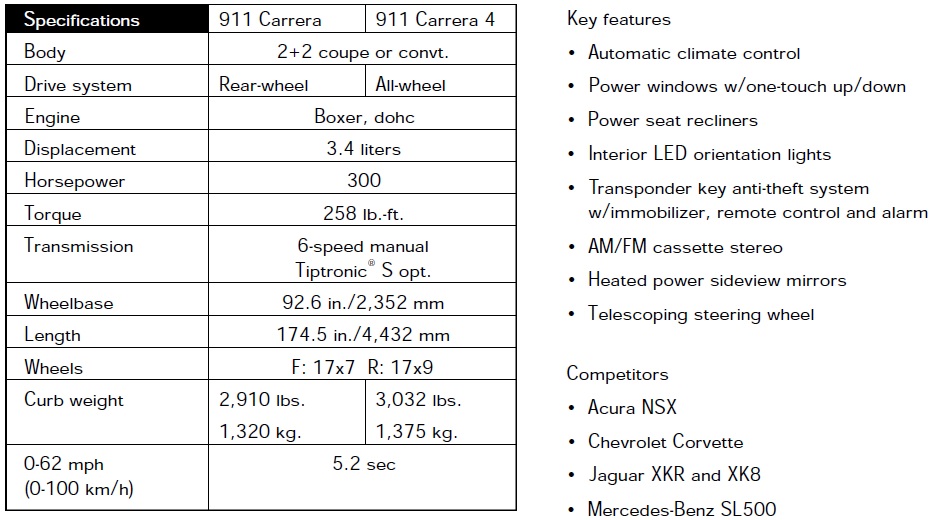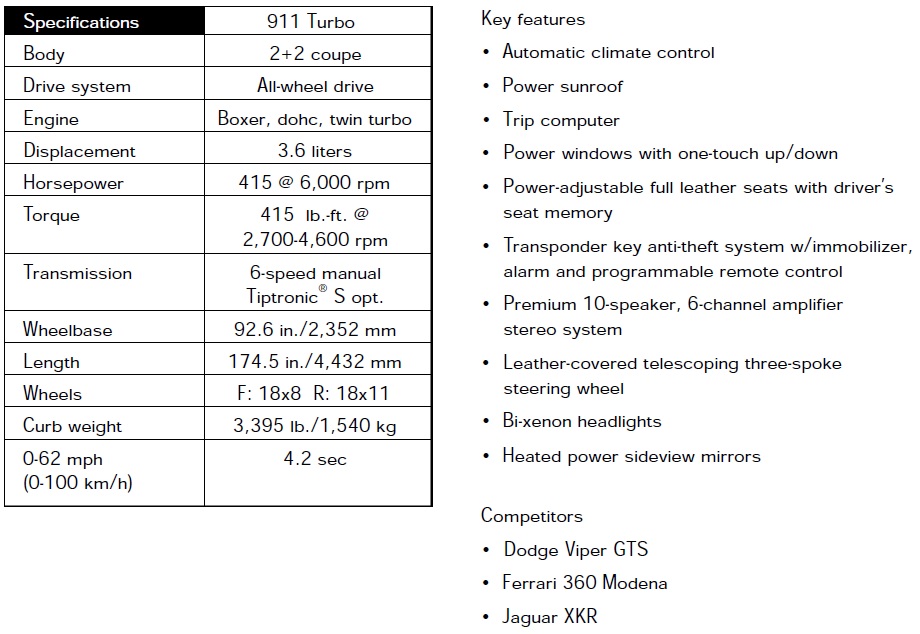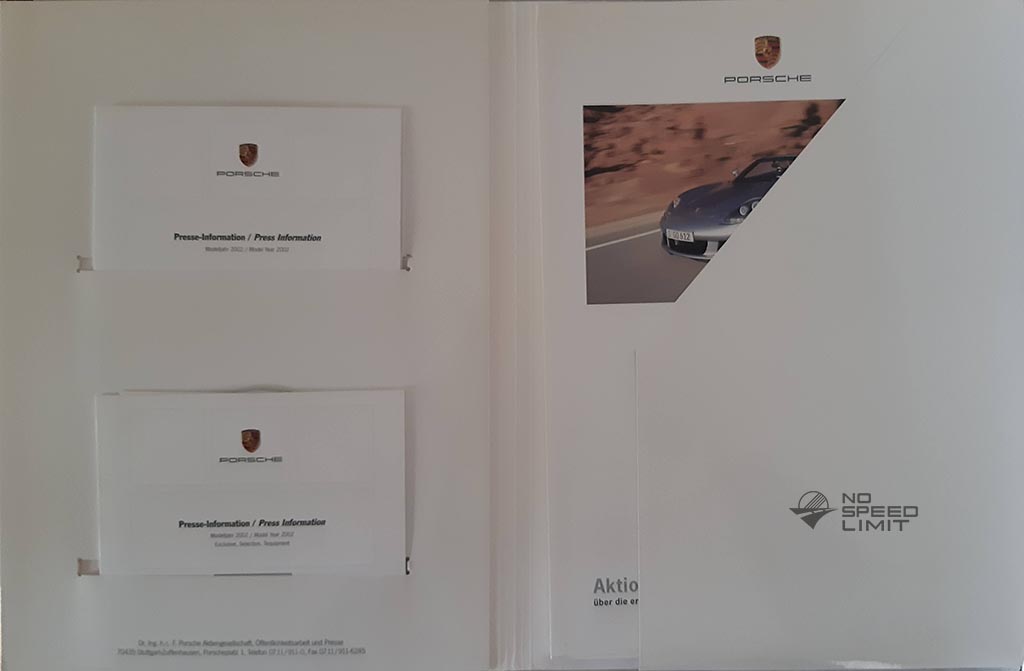.jpg)
2001: Porsche 'Carrera' GT Prototype
The Porsche® Boxster® is a mid-engine roadster with a design that echoes such classic mid-engine Porsche sports/racing cars as the 550 Spyder and RS60. Powered by a 2.7-liter, 217-horsepower six-cylinder boxer engine, the Boxster features a standard five-speed manual transmission. The Porsche Tiptronic S five-speed automatic is available as an option. Light weight combined with a broad torque curve and a roomy, comfortable interior make the Boxster the ideal sportscar for everyday driving. The standard power convertible roof lowers in just 12 seconds. An aluminum hardtop is optional.
The Boxster S offers even higher levels of performance, handling, and comfort. Powered by a 3.2-liter 250-horsepower engine, the Boxster S adopts the 6-speed manual transmission and larger cross-drilled brakes from the 911™ Carrera®. Larger wheels and tires and sport chassis tuning enhance the already-precise handling, and distinctive titanium-color exterior trim sets the Boxtser S apart from the standard Boxster.
The Boxster roof features a new cloth headliner (like the Boxster S) that reduces interior noise. The integrated supplemental safety bars are now covered in soft-touch material, and a new three-spoke steering wheel with color Porsche Crest® adds a sporty touch to the interior. New light emitting diode (LED) orientation interior lights, which were introduced on the 2001 911 Turbo, provide gentle illumination for the cockpit, console, ignition lock, and door latches. The front and rear trunks feature improved carpeting. The Porsche Stability Management (PSM) system is newly optional, and some popular options have been grouped into packages.

The new-generation Porsche® 911™ Carrera® and all-wheel drive 911 Carrera 4, introduced for model-year 1999, continue a tradition started in 1965 with the first 911. The 911 continually evolved over four decades and established a sportscar legend on the road and the racetrack. All 911 models have featured a rear mounted, horizontally opposed “boxer” six-cylinder engine and the same distinctive profile. The new-generation 911 Carrera and 911 Carrera 4 – in both Coupe and Cabriolet forms – share a modern interpretation of the unmistakable 911 design. Safety technology includes a patented crumple-zone body structure, dual front airbags, door-mounted side airbags, and anti-lock brakes. The 911 Carrera 4 all-wheel drive system uses a viscous multi-plate clutch mounted just behind the front differential. The Cabriolet models feature a fully automatic power roof, an automatic deploying supplemental safety bar structure, and a standard removable aluminum hardtop.
Porsche has added several convenience features to the 911 Carrera models. Interior orientation lights use light-emitting diodes (LEDs) to provide gentle illumination of the cockpit and center console, ignition lock and light switch, and door latches. The remote entry system adds enhanced functions, and the trunk features improved carpeting. Some popular options have been grouped into packages.

Porsche first introduced a 911 Turbo to North America for model-year 1976. The U.S.-spec version of that car produced 234 horsepower and could accelerate from 0-62 mph (0-100 km/h) in just under six seconds – extremely fast for the time. Today, with a 415-horsepower twin-turbo engine, all-wheel drive, and exclusive styling, the 2001 911 Turbo takes its place at the top of the Porsche model line and in the top echelon of the supercar category. The new 911 Turbo can accelerate from 0-62 mph (0-100 km/h) in just 4.2 seconds. On the test track, the car can achieve a top track speed of 189 mph (305 km/h). Unique design features include bi-xenon headlight clusters and a two-piece rear stabilizer wing. The upper portion of the wing automatically raises at speeds above 75 mph (120 km/h) and lowers at speeds below 50 mph (80 km/h). Derived from the Porsche GT1 racecar, the 3.6-liter, horizontally opposed six-cylinder engine features dual intercoolers and produces 26.8 psi (1.85 Bar) maximum boost – more than double any previous 911 Turbo. The new engine sustains 415 lb.-ft. (560 Nm) of peak torque from 2,700 rpm to 4,600 rpm. Power drives through a standard six-speed manual transmission, and, for the first time in a 911 Turbo, Porsche offers the Tiptronic S five-speed automatic transmission as an option. Also derived from the GT1 racecar, one-piece, four-piston brake calipers reduce unsprung weight and heat and feature 13-inch vented, cross-drilled discs front and rear. The Porsche Ceramic Composite Brake (PCCB™), available as an option (late availability), will set new standards for brake response, fade resistance and service life. The standard Porsche Stability Management system (PSM) can detect a loss of grip at the front or rear and reduce instability by applying braking to individual wheels and, if necessary, altering engine power.

.jpg)
2001: Porsche 'Carrera' GT Prototype

2002 production line

Porsche Press kit

Porsche Literature

Our Porsche Cars